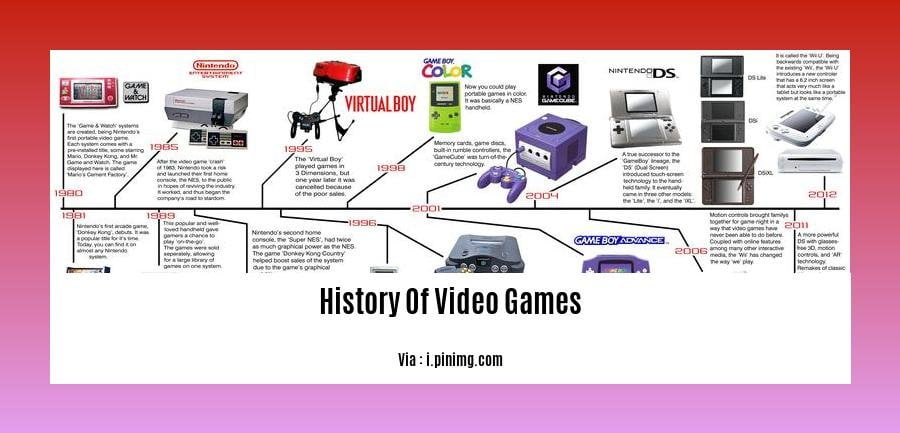Embark on [A Journey Through the History of Video Games] as we delve into the origins and evolution of this captivating medium. From the early fascination with the Tennis for Two prototype in 1958 to the groundbreaking systems of the 70s and 80s that ignited our love for gaming, we’ll explore the milestones and cultural impact that have shaped the industry into the boundless virtual world we know today.
Key Takeaways:
- Video games originated in the 1950s with “Tennis for Two.”
- Early consoles like Ralph Baer’s “Brown Box” paved the way for home gaming.
- The North American video game crash in 1983 gave rise to Japanese dominance in the industry.
- PC gaming and Microsoft’s Xbox console revolutionized the market.
- Massively Multiplayer Online Games (MMOGs) popularized online multiplayer gaming, leading to titles like “World of Warcraft.”
History of Video Games

Strap yourself in, my fellow gaming enthusiasts, as we embark on an exciting expedition through the history of video games, a timeline filled with innovation, cultural impact, and unforgettable experiences. From humble beginnings to the modern marvels we enjoy today, let’s dive in!
The Dawn of Digital Gameplay
In the mid-20th century, the seeds of virtual entertainment were sown. Remember the “Tennis for Two” demonstration in 1958? That rudimentary game laid the foundation for the interactive journeys to come.
Consoles and Arcades Take the Stage
Fast forward to the ’60s and ’70s, when home consoles like the “Brown Box” and arcade classics like “Space Invaders” ignited a gaming revolution. These early pioneers paved the way for the vibrant gaming landscape we know today.
Crash and Revival: The Roller Coaster Ride
The industry hit a bump in 1983 with the infamous North American video game crash. But like a phoenix rising from the ashes, innovation emerged from Japan, giving birth to iconic consoles like the Nintendo Entertainment System (NES) and the Sega Genesis.
The PC Era and Microsoft’s Impact
The ’90s ushered in the era of PC gaming and the rise of Microsoft’s Xbox console. With increased processing power and online capabilities, the gaming experience took a monumental leap forward.
The Online Revolution: MMOGs and Beyond
The early 2000s witnessed the explosion of massively multiplayer online games (MMOGs) like “World of Warcraft.” These virtual worlds connected players from across the globe, fostering unforgettable social interactions and epic online battles.
Today, the history of video games continues to unfold, with advancements in graphics, storytelling, and immersive technologies shaping the future of entertainment. From retro classics to cutting-edge masterpieces, the journey has been an exhilarating one. So, grab your controllers and let’s continue exploring the ever-evolving realm of video games!
You can dive deeper into the evolution of early arcade games here to see how they shaped the gaming landscape.
The home console development here played a crucial role in bringing gaming into our living rooms, revolutionizing the way we experience interactive entertainment.
Explore the fascinating world of esports here, where competitive gaming has become a global phenomenon, attracting millions of players and fans.
The 1970s: The Rise of the Video Game

The 1970s marked a significant turning point in the history of video games. This period saw the dawn of home video game consoles, which revolutionized the way people experienced gaming.
Home Consoles Take Center Stage
The release of the Magnavox Odyssey in 1972 is widely considered the birth of home video game consoles. This pioneering console featured built-in games and cartridges that could be swapped in and out. Other companies, such as Atari and Coleco, soon followed suit, releasing their own home consoles.
Arcade Games Captivate the Masses
While home consoles were gaining popularity, arcade games also took the world by storm. Games like Pong, Space Invaders, and Pac-Man became instant classics, attracting crowds to arcades and inspiring a new generation of gamers.
Pioneering Technology
The 1970s also saw major advancements in video game technology. The introduction of microprocessors allowed for more complex graphics and gameplay. Color graphics and sound chips further enhanced the gaming experience.
Key Takeaways:
- The 1970s witnessed the dawn of home video game consoles.
- Arcade games became a cultural phenomenon, attracting large crowds.
- Advancements in technology led to more complex and immersive video game experiences.
Sources:
- History of Video Games
- The Evolution of Video Games
The 1980s: The Crash
The 1980s dawned with the promise of a golden age for video games. Arcades were booming, and home consoles were becoming increasingly sophisticated. But the industry’s rapid growth masked an underlying problem: oversaturation.
By 1983, the market was flooded with consoles and games, leading to intense competition and a glut of low-quality titles. Consumers grew disillusioned, and the industry plummeted into a deep recession known as The 1980s: The Crash.
Contributing Factors:
- Market Saturation: The sudden influx of consoles and games created a surplus, leaving retailers with excess inventory.
- Low-Quality Games: The rush to release new games led to a decline in game quality, further eroding consumer trust.
- Unrealistic Consumer Expectations: The industry had hyped video games as the next great entertainment medium, but many releases failed to live up to the hype.
The crash had a devastating impact on the industry, with several companies going bankrupt and many others downsizing. But it also paved the way for a revival, with survivors such as Nintendo and Sega emerging stronger than ever.
Key Takeaways:
- Market saturation and low-quality products can lead to industry crashes.
- Consumer expectations must be managed realistically.
- Even in times of adversity, innovation and resilience can bring about renewal.
Relevant URL Sources:
- Wikipedia:
- The Dot Eaters.com:
FAQ
Q1: What were the major milestones in the early history of video games?
A1: The early history of video games saw several significant milestones, including the creation of OXO, the first graphical video game (1952), and the invention of “The Brown Box,” the prototype for the first home video game system (1967).
Q2: What factors contributed to the video game crash of 1983?
A2: The video game crash of 1983 was caused by a combination of factors, including market saturation with video game consoles, an influx of low-quality games, and unrealistic consumer expectations.
Q3: How did the video game industry evolve in the 1970s?
A3: The 1970s witnessed the rise of the video game industry with the introduction of arcade games like Pac-Man and the release of home video game consoles such as the Atari 2600.
Q4: What were the key developments in video games during the 1980s?
A4: The 1980s marked the era of the “golden age” of video games, with the release of iconic titles like Super Mario Bros., Tetris, and the rise of personal computers for gaming.
Q5: What were the major trends that shaped the evolution of video games in the early days?
A5: The early evolution of video games was influenced by advancements in technology, the rise of home computing, and the emergence of arcade culture, which fostered innovation and competition.
- Discover Northern Pakistan’s Hidden Gems: Your Ultimate Guide - March 27, 2025
- Explore Eastern Canada: Unforgettable Adventures Await - March 27, 2025
- Unlock New St. John’s Potential: Education & Faith - March 27, 2025
















